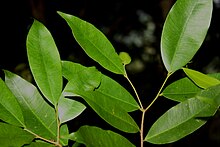Gyrinops
| Gyrinops | |
|---|---|

| |
| Leaves of Gyrinops walla | |
| Scientific classification | |
| Kingdom: | Plantae |
| Clade: | Tracheophytes |
| Clade: | Angiosperms |
| Clade: | Eudicots |
| Clade: | Rosids |
| Order: | Malvales |
| Family: | Thymelaeaceae |
| Subfamily: | Thymelaeoideae |
| Genus: | Gyrinops Gaertn. |
Gyrinops is a genus of nine species of trees, called lign aloes or lign-aloes trees, in the family Thymelaeaceae.[1] They are native to Southeast Asia and the Indian Subcontinent.
The genus Gyrinops is closely related to Aquilaria and in the past all species were considered to belong to Aquilaria.[2]
Agarwood production[edit]
Together with Aquilaria the genus is best known as the principal producer of the resin-suffused agarwood.[3][4] The depletion of wild trees from indiscriminate cutting for agarwood has resulted in the trees being listed and protected as an endangered species.[5][4][3]
Projects are currently underway in some countries in southeast Asia to infect cultivated trees artificially to produce agarwood in a sustainable manner.[5] In Indonesia, for example, there have been proposals to encourage the planting of gahara, as it is known as locally, in eastern Indonesia, particularly in the province of Papua.[6]
Species[edit]
- Gyrinops caudata (Gilg) Domke
- Gyrinops decipiens Ding Hou
- Gyrinops ledermanii Domke
- Gyrinops moluccana (Miq.) Baill.
- Gyrinops podocarpus (Gilg) Domke
- Gyrinops salicifolia Ridl.
- Gyrinops versteegii (Gilg) Domke
- Gyrinops vidalii P.H.Hô
- Gyrinops walla Gaertn.
References[edit]
- ^ EOL - Gyrinops
- ^ Blanchette, Robert A. (2006) "Cultivated Agarwood - Training programs and Research in Papua New Guinea", Forest Pathology and Wood Microbiology Research Laboratory, Department of Plant Pathology, University of Minnesota
- ^ a b Barden, Angela (2000) Heart of the Matter: Agarwood Use and Trade and CITES Implementation for Aquilaria malaccensis TRAFFIC International, Cambridge, ISBN 1-85850-177-6
- ^ a b Ng, L.T., Chang Y.S. and Kadir, A.A. (1997) "A review on agar (gaharu) producing Aquilaria species" Journal of Tropical Forest Products 2(2): pp. 272-285
- ^ a b Broad, S. (1995) "Agarwood harvesting in Vietnam" TRAFFIC Bulletin 15:96
- ^ Theresia Sufa, 'Gaharu: Indonesia's endangered fragrant wood', The Jakarta Post, 2 February 2010.
